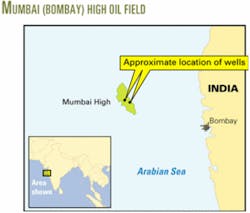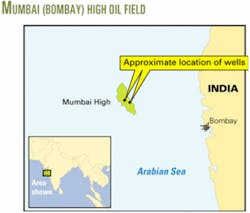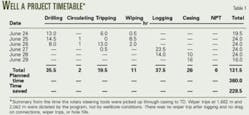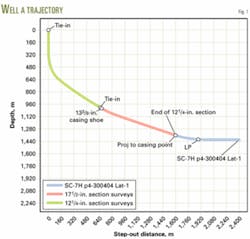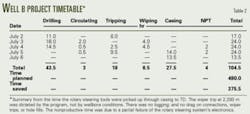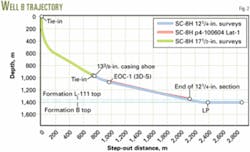India's Oil & Natural Gas Corp. Ltd. used a different approach to improve extended reach drilling through shales at its offshore Mumbai (Bombay) High oilfield.
In a field on the south side of the Mumbai High area, two long well sections, 1,008 m (3,307 ft) and 1,429 m (4,685 ft), were drilled through shale in 35.5 and 43.5 hr, respectively. The ONGC project team (subsurface group of Mumbai High Asset and Drilling Services) was able to drill the section fast and case it affordably, saving drilling time and producing quality wellbores.
Improving drilling performance required an initial investment and effort to bring together the necessary technologies, equipment, and expertise. Using strengths-weaknesses-opportunities-threats (SWOT) analyses, judicious selection of technology, evaluation of available and appropriate resources, and timely integration, the project team was able to drill long, high-angle wellbore sections through the problematic shale formation.
The shale challenge
In ONGC's Mumbai High offshore field, drilling wells through shale is problem ridden. Although water-based muds incorporating KCL-PHPA or glycol control the shale instability to a certain extent, their performance remained unsatisfactory in maintaining shale stability during prolonged drilling operations. Problems persisted, with significant trouble shooting downtime and stuck pipe.
Drilling horizontal and extended reach horizontal wells has become common in developing the Mumbai High field. The introduction of LWD (logging while drilling) and MWD-GR (measurement while drilling, gamma ray) packages, positive-displacement motors (PDMs), PDC bits, and top-drive systems now enable drilling contractors to drill long, high-angle-hole sections in shale formations.
Higher angle and longer section drilling in shale formations had exceeded the capabilities of water-based mud systems (WBMs) and pushed the performance of rig and equipment to their limits. Engineers sought to:
Increase mud weight for better stability of shale formation, which correspondingly increased drillstring pressure loss and surface pump pressure and decreased discharge limits.
Reduce generation of small size formation cuttings.
Reduce development of cutting beds in build sections due to slide-rotate protocol of directional tools.
Reduce repeated round trips due to MWD-PDM failures.
These factors contribute to the increase in formation exposure time during drilling, which is reflected in tight wellbore conditions, borehole collapse, cutting fills, and sticking.
The drilling engineering challenge at the Mumbai High field is to limit the exposure time of the shales to drilling fluids in order to mitigate downhole problems and produce better quality wellbores.
The plan
In the Mumbai High field, the average time taken to drill 1,000 m of section in shale formation is more than 15 days. Many wells, with equal or shorter section lengths in shale formation, are being drilled to the top of reservoir.
Starting from an angle of 55° at the top of shale section, the wellbore angle is built to 75° to 90° to reach the top of reservoir using MWD or LWD packages with PDMs, premium TCR bits, and KCL-PHPA or glycol mud systems.
The Mumbai High subsurface group planned to drill more than 1,000 m of high-angle section in a shale formation. Following SWOT analysis, the plan was turned into a live project. To improve drilling performance, the project team broadly embraced twin objectives:
Introducing new-generation directional drilling tools (RSS), synthetic oil-based mud system (SOBM), and PDC bits with affordable capital expenses.
Selecting a jack up rig and maximizing its performance using available resources, such as top drive, spill control, linear motion shale shakers, centrifuge, surface mud system, and large diameter drill strings.
New tools
To reach the first objective, ONGC chose Schlumberger Ltd.'s Power Drive 900 rotary steering system (RSS) for directional control in an attempt to create a smooth wellbore trajectory during drilling. A four-arm caliper log was used to assess the borehole size after drilling the section.
For the SOBM, ONGC chose MI Overseas Ltd.'s EDC-95-11, low toxic-low aromatic mud system. This was expected to counter shale instability and keep a minimal overbalance on formation pressure while drilling. The mud system reduced drill string pressure losses, provided a higher discharge rate for better well bore cleaning and cutting transportation, and reduced discharge pressure load on mud pumps.
ONGC chose a 121/4-in. PDC bit (with RSS package) in order to generate large size cuttings, increase the rate of penetration (ROP), and get better maneuverability while drilling high angle sections.
Jack up rig
The second objective of the project plan called for the use of an oil-based mud (OBM) compatible jack up rig with top drive, linear motion shale shakers, and experienced crew. The top drive permits continuous rotation of drill string while drilling, pipe connection, and trips if required with circulation.
Engineers incorporated ceramic liners in mud pumps for long, trouble-free runs.
Existing 5 in. drillstrings were replaced by 51/2-in. drillstrings to minimize drill string pressure losses, and create sufficient turbulence in the well annulus while drilling, enabling the drilling fluid system to whip up cutting movement and reduce generation of cutting beds.
The second objective also included writing the well plan, with allowance for rig preparation, back-up requirements, and essential services.
Execution
The operator identified two separate well sections, 1,010 m and 1,500 m long.
After inspection, ONGC's Drilling Services, Mumbai Offshore, deployed Transocean Inc.'s Ron Tappmeyer, an OBM-compatible jack up rig with top drive, for the project. The rig was equipped with 51/2-in. drill string, linear motion shale shakers, centrifuge, zero discharge mud-management system, and OBM-experienced crew.
MI-Overseas Ltd. provided a low toxicity, low-aromatic, EDC-95-11 mud system and mud-engineering services. Schlumberger provided a Power Drive 900 rotary steerable system with MWD-GR and a 121/4-in. PDC bit. Technicians also fine-tuned the well path plan and provided directional management services.
Well A
At Well A, a 133/8-in. casing shoe was set at 1,310 m with an inclination at shoe of 58.4°. Using a 121/4-in. PDC bit, the contractor drilled a 1,008 m section to 2,320 m TD, achieving 70.8° at the top of reservoir (Table 1). The actual drill time taken was 35.5 hr.
The section drilling resumed with 10.2-ppg mud and was increased to 10.6 ppg in order to maintain an overbalance of 0.4 ppg over formation pressure. The mud weight of 10.6 ppg was much lower than the 12.5 ppg used in WBMs to drill the same formation in nearby wells.
The combined technologies of OBM system, rotary steerable system, PDC bit, and larger drill pipe produced the desired results. Discharge of 850 gpm was maintained throughout the drilling operation and the equivalent circulating density (ECD) measurement derived by the annular pressure while drilling (APWD) tool varied around 11.2 ppg.
Two wiper trips made at 1,662 m and at 2,062 m well depth indicated no drag or fill. The four-arm caliper of Schlumberger indicated an average hole size of 12.7-in. (Fig. 1). The 95/8-in. casing was lowered to the TD of 2,320 m without the customary bit trip and the cement was pumped as planned from TD to the 133/8-in. shoe.
Well B
At Well B, the caliper log was not included; the only change incorporated was the replacing of a Power Drive 900 restrictor for maintaining a 950-gpm discharge rate. At Well B, the 133/8-in. casing shoe was set at 1,331 m with an inclination of 56.3° at the shoe.
Using a 121/4-in. PDC bit, the contractor drilled a 1,429-m section to the TD of 2,760 m, achieving 76.15° at the top of reservoir (Fig. 2). The actual drill time for the section was 43.5 hr (Table 2).
At Well A, the section drilling was resumed with 10.2-ppg mud weight and increased steadily to 10.75 ppg, maintaining an overbalance of 0.55 ppg over formation pressure. The APWD tool measured 11.4-ppg ECD.
The ROP was steadily increased to 33 mph (108 fph) during section drilling. Only one wiper trip was made after drilling 962 m (3,156 ft) of section indicated smooth well bore with no cutting build up or fill. The 95/8-in.-diameter casing was run directly to TD at 2,757 m and cemented according to plan from TD to 133/8-in. shoe.
Lessons learned
Compared to 5-in. drill pipes, the larger inside diameter of 51/2-in. drill pipes and lower mud weights helped in reducing string pressure losses at required higher discharge rates. The tool joint size of 51/2-in. drill pipe created a whipping action during rotation that allowed a large volume movement of cuttings while drilling in 121/4-in. hole.
Oversized tool joints, which restrict the movement of cuttings, must be avoided in order to reduce annular mud loading. Hole-cleaning experience revealed that controlled ROP is essential to minimize loading the annulus with drill cuttings.
The power-drive system is vulnerable to surface commands. Repairing electronics of the rotary steering system or any problem related to directional pads or PDM may require additional round trips. A multideck linear motion shale shaker or cuttings dryer may be required to handle the larger volume of cuttings and to recover more SOBM mud residue.
ECD variation and drilled cutting size and quantity on the shale shaker are the keys to understanding wellbore conditions during drilling. With all the inputs, engineers can attain a high level of confidence in the section to be drilled.
Project success
The key elements for financial and operational success include: SWOT analysis of the project, judicious selection of technology and equipment, evaluation of available serviceable resources, system integration, quick response times, and use of experienced personnel.
The oil-based mud system proved to be a better option for drilling high-angle wellbores in the shale formation than water -ased mud systems.
Overall, the operator saved 10 rig days on Well A and 14 rig days on Well B and the resulting wellbores were of good quality.
Using efficient, appropriate equipment and systems with effective project management allowed the Mumbai High Asset Group of ONGC to drill the section fast and case it affordably.
The authors
Devang N. Balraj (ballubalraj @yahoo.co.in) is a superintendent engineer in drilling operations at Mumbai High Asset Subsurface Group of Oil & Natural Gas Corp. Ltd. (ONGC), Mumbai, India. He has worked for ONGC since 1982, and has also served as jack up rig manager, offshore drilling engineer, and onshore exploratory drilling at ONGC. Balraj holds a BE in mechanical engineering (1980) from Bangalore University, Bangalore, India.
Rama Dhar Navani (navanirdn @rediffmail.com) is chief chemist of the Mumbai High Asset Group, Oil & Natural Gas Corp. Ltd., Mumbai, India. He has worked for ONGC since 1967, in field mud engineering, drilling fluid research and development, and field implementation in drilling operations. Navani holds a MSc in chemistry (1965) from Agra University, Agra, India.
